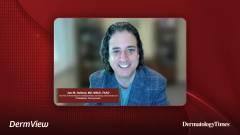
Clinician Confidence in Biosimilars
Roy M. Fleischmann, MD, and Joel M. Gelfand, MD, MSCE, FAAD, address the importance of clinician confidence in biosimilars.
Episodes in this series

Roy M. Fleischmann, MD: Let me ask 2 questions. Let’s assume that there are several biosimilars of adalimumab available as well as the reference product, and for your patient, using the biosimilar is cheaper. They have better access. Let’s do the pie in the sky and say that. Would you feel more comfortable prescribing a biosimilar that has an interchangeability designation rather than one that doesn’t? Would you have more confidence in that drug?
Joel M. Gelfand, MD, MSCE, FAAD: It’s an interesting question. I’m not sure how to answer it. Ultimately, if it’s designated as a biosimilar, I still feel fairly comfortable using that product because at least it has been shown to not have important variation in chemical structure, and it has good clinical data from head-to-head studies that you get similar outcomes. The advantage might be that we’ll have to be notified that there’s going to be a switch made to the product designated interchangeable at this point in time. But it’s true: the more data we have, the more confidence we’re going to have. Having the interchangeable designation is likely to reassure some concerns for colleagues.
Roy M. Fleischmann, MD: How would you address biosimilars with patients? We’ve said that with the treatment-naive patient, we both feel very comfortable using a biosimilar or bio-original. They seem to be similar. We have a little difference in confidence regarding switching a patient who’s doing well to a biosimilar. You’d be a little more reluctant if you had the choice than I’d be. Is that correct?
Joel M. Gelfand, MD, MSCE, FAAD: I’d be comfortable if the patient otherwise has a fairly simple prior history of treatment management. We get into challenges in dermatology spaces when a patient cycles through therapy after therapy and is getting toward the end of the line in what treatments we can use for them. In that case, it may be a moot point because we’d be on to IL-17 and IL-23 inhibitors for those patients. But patients who are rapid cyclers and lose response quickly to a biologic are the folks I’m concerned about regarding interchangeability until we have more data in that subpopulation of people.
Roy M. Fleischmann, MD: That’s a very interesting point. That’s the difference between a rheumatologist and a dermatologist. As a rheumatologist—let’s assume it’s PsA [psoriatic arthritis]; let’s use the same disease—I may want to use a TNF [tumor necrosis factor] inhibitor first. I have more experience with it, I like it, and the patient has more coverage with TNF. If the patient has been on the TNF as the first drug after methotrexate and is doing well, I feel pretty comfortable that I can try and switch to a biosimilar. I don’t think everyone will respond, but the vast majority will. But if you’re a dermatologist, you might not have used a TNF first, right?
Joel M. Gelfand, MD, MSCE, FAAD: That’s right.
Roy M. Fleischmann, MD: You might have used an IL-17 first. In even worse conditions, you might use an IL-23 first. You might go to an IL-17, IL-23, and then the TNF…drug.
Joel M. Gelfand, MD, MSCE, FAAD: Increasingly in our clinical practice, IL-17s and IL-23s are first-line [therapy] because in head-to-head trials they’re more effective products and much more likely to get patients nearly clear or completely clear of their disease, and they also have what we call longer persistence. If you look at the persistence curves of patients on a TNF compared with an IL-17 or an IL-23, patients persist on therapy longer with the IL-17s and IL-23s than they do on a TNF. We think that’s largely because of loss of response over time that occurs commonly with people with psoriatic disease.
Roy M. Fleischmann, MD: There may be a difference between rheumatologists and dermatologists. As you said, it’s earlier disease vs later disease. Your patient will be more complex if they failed 2 methods already. Mine won’t. Then the last one: We both agree that for patients who failed a TNF, I’m not going to a biosimilar TNF, right?
Joel M. Gelfand, MD, MSCE, FAAD: Yes, I agree. It will be interesting to see if we’re forced to. Because right now we’re experiencing that if patients failed adalimumab, and I’m told I have to use etanercept, in the field of psoriasis, that makes little sense because we know that adalimumab is generally more effective in the skin than etanercept is, especially if it’s a heavy patient. But the payer often dictates what we’re able do, and we have to soldier through and go through a period of time of trying a product that’s pretty unlikely to work if a patient had primary failure within the mechanism of action. We’ll have to see what policies come to bear. For a lot of us, those are the things you have to look out for. Where am I comfortable allowing the switch or starting with the biosimilar at the get-go? In most cases, the answer is that you should be fine. But obviously there are cases where you need to think a little more about the patient.
Roy M. Fleischmann, MD: In the old days—this may be before your time—when we only had TNFs, we did the switches and there were patients who did well switching within the new class.
Joel M. Gelfand, MD, MSCE, FAAD: Yes, that’s right.
Roy M. Fleischmann, MD: It might have been 50% of patients, compared with switching the mechanism, where you make it 70% or 80%.
Transcript edited for clarity
Newsletter
Like what you’re reading? Subscribe to Dermatology Times for weekly updates on therapies, innovations, and real-world practice tips.
















